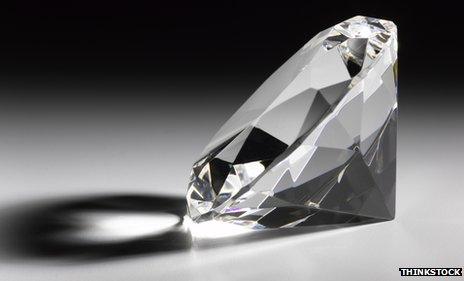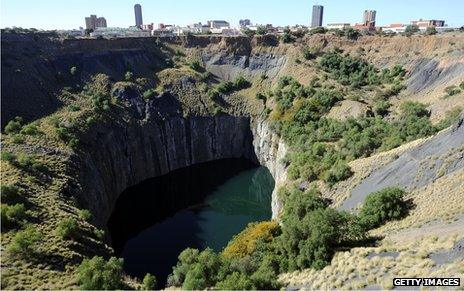Who, What, Why: How do you spot a stolen diamond?
- Published

Armed robbers made off with a massive haul of diamonds in Brussels, but is it possible to spot a stolen gem?
The diamonds lost in the Belgian heist are worth $50m (£32m; 37m euros) and there's been speculation they may never be recovered.
Art thieves face a formidable challenge in disposing of famous works - to capitalise on the theft they must sell them. Any art dealer presented with a Picasso or a Rembrandt is going to know the piece has been stolen.
But can stolen diamonds be equally distinctive to the dealers through whose hands they would pass?
Uncut or rough diamonds do have distinctive characteristics, coming in many different shapes, sizes and, colours. They can be twisted or two diamond masses can be stuck together.
We tend to think of diamonds as translucent or bluish white but they can also be blue, brown, red, yellow, pink, black, or green, depending on the presence of elements other than carbon and on radiation.
The shape of rough diamonds will also depend on whether they come from a mine or from a beach or river. So-called alluvial diamonds are smoother edged than mined diamonds.
They could theoretically therefore be distinctive to an eagle-eyed dealer who knew that a particular group of diamonds was stolen.
But this is all about rough diamonds. It's harder to guess where a cut and polished diamond has come from.
And even then the idea of distinguishing rough diamonds based on their characteristics is not really practical because of the nature of the trade.
Antwerp near Brussels is a centre for the sorting of diamonds. The stolen diamonds could have come from mines around the world and been sorted and graded in Antwerp before being moved on.
The diamonds in the heist will be recorded on the basis of weight in carats, colour and clarity. For polished diamonds the cut would also be included.

The diamonds were taken from Brussels International Airport
But there is not enough information to build up a "diamond e-fit".
So if it's hard to tell a stolen diamond by sight, can they be distinguished on the basis of their paperwork or lack of?
The UN developed the Kimberley Process to monitor the trade in rough diamonds and prevent gems being used to fund violence.
Before they can be exported, all rough diamonds need to have a certificate from the government of the country they were mined or found in.
In essence, this certificate says that the diamonds have not been used to finance crime. In theory, all countries that are part of the Kimberley Process issue these certificates.
In practice however, some countries, such as Venezuela, do not.
The Kimberley Process only applies to rough diamonds as they cross borders. It does not apply to sales of rough diamonds within a country. Such sales would be authenticated with an invoice, which could of course be falsified.

The Big Hole diamond mine in Kimberley, South Africa, went out of use in 1914
India cuts and polishes 90% by value of the world's diamonds. The other main places for cutting and polishing are China, Israel and the United States.
The thieves would need to smuggle the diamonds into any of these countries, but once they were in, forging paperwork would allow them to be sold on.
Diamonds can also be marked by a laser with a little symbol invisible to the eye. Lazare Kaplan, a US based diamond manufacturing and distribution company, developed this form of inscription.
It is not known if any of the diamonds stolen in the heist were marked in this way and as former gem broker Christopher Hourmouzios stresses, "whatever is cut on to a diamond can be taken off it".
"These people were not amateurs, they won't be thinking about how they get rid of these diamonds now, they will have probably got the route planned in advance," says Ian Smillie, author of Blood on the Stone: Greed, Corruption and War.
"There's likely to be more rough than polished stones," says Smillie. "From Switzerland the diamonds were probably on their way to India."
The thieves have several options. The first is to sell them on soon. However, to do so they may have to accept a large loss on the legitimate value of the stones.
The second is to sell them to factories where the diamonds will be cut and polished. Once a diamond is cut up and polished its origins are effectively disguised.
"If the thieves can evade customs checks in India then they can take them to a plant and sell them and no one will be the wiser," says Smillie.
So if the diamonds are cut and polished they may never be returned to their rightful owners.
The thieves or whoever they sell the polished diamonds on to will not want to cut them up as that would reduce their value.
Instead, their origins can be disguised by what is known as diamond round-tripping, where polished diamonds are traded between India and Dubai up to half a dozen times. This trade can be used to disguise the origin of diamonds before sale.
"The diamonds will be sold on in small quantities in various cities around the world," suggests Hourmouzios.
It may be that very few are ever recovered.
You can follow the Magazine on Twitter, external and on Facebook, external